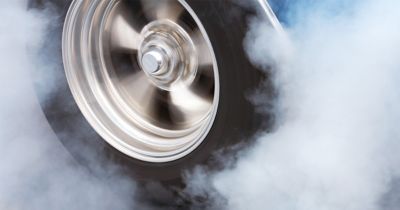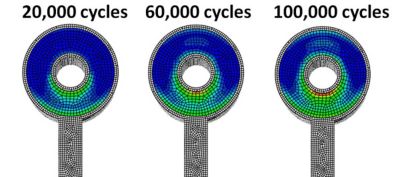ANSYS BLOG
August 31, 2022
Bouncing Off Ideas
How Ansys and Endurica are co-simulating better rubber automotive component outcomes.
Professional NASCAR driver Dale Earnhardt Jr. claims that a good day involves executing at least three burnouts.1 Burning rubber in a high-performance vehicle involves a lot of engine noise, smoke, and wheel spinning as tires dissolve. It’s exciting, for sure, but it’s also a luxury the average driver doesn’t have. The material and structural properties of most tires are specifically designed to withstand temperature and air pressure fluctuations, loading imbalances, and the stresses and strains that come with everyday driving over longer periods of time. In either scenario, whether you’re on the road or at the track, there are forces at play that determine just how long tires will last.

Endurica offers comprehensive tools and workflows for fatigue analysis of elastomers in partnership with Ansys simulation solutions, including simulation and material characterization services. These co-simulations support the thorough analysis of rubber engine mounts, bushings, seals, and, of course, tires to predict and extend the life of these critical automotive components.
“Many rubber parts go into a vehicle,” says Will Mars, president and founder of Endurica. “During a recent presentation, GM executive Mike Anderson was talking about the supply chain and their expectations for rubber parts suppliers. As part of the bid package for new business for a rubber part supplier, virtual validation of durability is going to be a requirement in the very near future. Our partnership with Ansys is helping suppliers to fulfill this requirement.”
Setting Stretch Goals with Simulation
Simulation is definitely a competitive advantage if you are an automotive rubber parts supplier. Original equipment manufacturers (OEMs) typically seek bids from two to five suppliers to support a program, with the winning supplier receiving a multiyear contract to produce parts. The winning supplier has to bring the most value, not only by optimizing rubber durability, but also by demonstrating advantages in light weighting, sustainable materials and cost. At this stage, to stand out is a function of product optimization, and Ansys simulation software really hits that sweet spot for suppliers like Endurica. At the same time, Endurica supports Ansys customers in providing the behavioral piece that helps them to see how rubber material evolution impacts structural performance — forming the basis for a lucrative co-simulation partnership.

Co-simulation process between the Ansys Mechanical solver and Endurica DT to accurately predict product life. Using the Ansys-computed state of stress, strain, and temperature, Endurica DT periodically updates the elastic and fatigue properties of rubber to account for incremental damage due to aging or cyclic softening.
Automotive rubber components are regularly subject to cyclic loading conditions (continuous, repeated application of a load) involving the fluctuation of stresses, strains, forces, and tensions that contribute to material degradation and lead to fatigue. Suppliers are looking for ways to anticipate these events before their components ever see pavement. The Ansys-Endurica co-simulation partnership was conceived to support rubber analysis. Ansys simulation software can calculate what is happening within the structure in terms of stress and strain history. Endurica then takes the resulting data a step further.
“Our software checks every element for the growth of microscopic cracks,” says Mars. “If you give us the stress-strain history from Ansys along with material properties of your rubber compound, we can then compute how long it will take for a crack to develop. That's what our software does.”
Cracking the Stress-Strain Challenge
The fatigue behavior of rubber in the Endurica software is specified in terms of fracture mechanical parameters. For a given level of input energy (i.e., tearing energy), engineers want to know what the corresponding rate of crack growth is. The life calculation is based on critical plane analysis, which is an extension of the simple idea that anywhere within your rubber part, you are likely to have some type of microscopic crack precursor. Some precursors will grow faster than others, depending on local conditions and the orientation of the crack. Critical plane analysis involves integrating the crack growth rate law for every possible crack orientation, and then finding the one particular orientation that yields the shortest life. That’s the basic framework.
A little crack in a tire or a rubber seal may not sound like much — until it results in failure. Let’s say a manufacturer has $10 million worth of rubber product in service. A certain percentage of those products may experience premature failures. If you could reduce the rate at which these products fail by just 1%, this incremental adjustment could significantly lower costs.
Without simulation, a manufacturer may have to wait several years before their parts begin to show early failures. By the time these costs start accruing, the manufacturer is already committed to the design — the decisions have already been made. Using simulation up front, suppliers can better address the possibility of failure, which results in fewer adjustments. And, if they are starting to get back adjustments because of a new failure mode, simulation provides the fastest way to investigate and respond.

Results from Endurica DT showing evolution of damage of rubber bushing component subjected to cyclic loading
When is the best time to use co-simulation workflows? When you have aging or cyclic softening of a material. Having co-simulation capability enables customers to determine how the stress strain field is evolving with cycles, or over time. In this case, to make this determination requires the user to iteratively go back and forth between Ansys and Endurica software to update the mechanical fields and material properties. This basic workflow can take in stress and strain results from structural finite element analysis (FEA), as well as the effects of temperature through thermal finite element analysis.
Ansys-Endurica Partnership Demystifies Rubber Material Evolution
Working together, Ansys and Endurica are helping automotive tier one suppliers anticipate, identify, and address automotive-related material challenges that lead to failure in the production of tires, bushings, engine mounts, and seals through co-simulation. Just how does this partnership work? For a given rubber component, it begins with a load history generated by Ansys Mechanical simulation software, during which the materials are specified. That data is then loaded into Endurica CL to compute the fatigue life of the rubber part.
If you want to analyze a series of load cases, Ansys data can also be imported into Endurica DT, an incremental solver and CL add-on. Endurica EIE is the fastest way to analyze Ansys data from recorded test signals (up to six channels) to fatigue life prediction. Endurica EIE with CL or DT can also simulate the full experience of a part in service. With support from Ansys, Endurica's proven simulation solutions deliver the versatile, well-validated fatigue life simulation results for elastomers to determine how rubber changes over time and the remaining life of an automotive part.
Consider a hydro mount analysis, a rubber component responsible for the vibration isolation in a vehicle. What is the fatigue like for the rubber in this mount if it is loaded up and down axially? To answer this question the user can first go into Ansys to make a model, then solve for the history of the strain as they go through the model. Once this is established, the results can be sent to Endurica to run further simulations before coming back and calculating the corresponding fatigue life. A material definition is set up in Mechanical, and then the strain history and times scales are exported into Ansys Workbench before setting up a simulation in CL.
“Ansys has a long history of modeling rubber materials,” says Mars. “Ansys Mechanical has really nice support for numerous hyperelastic functions to help understand nonlinear stress strain behavior, finite straining, finite deformations, and other phenomenon associated with rubber components. And, they have the capabilities needed to accurately represent all of the environmental factors these components will come in contact with.”
If you’d like more information on the Ansys-Endurica co-simulation partnership, including the unique workflows used for successful analysis of rubber components, you can view the webinar Get Rubber Durability Right, Featuring Endurica on demand.
How to Burn Rubber | GQ, August 2, 2003.